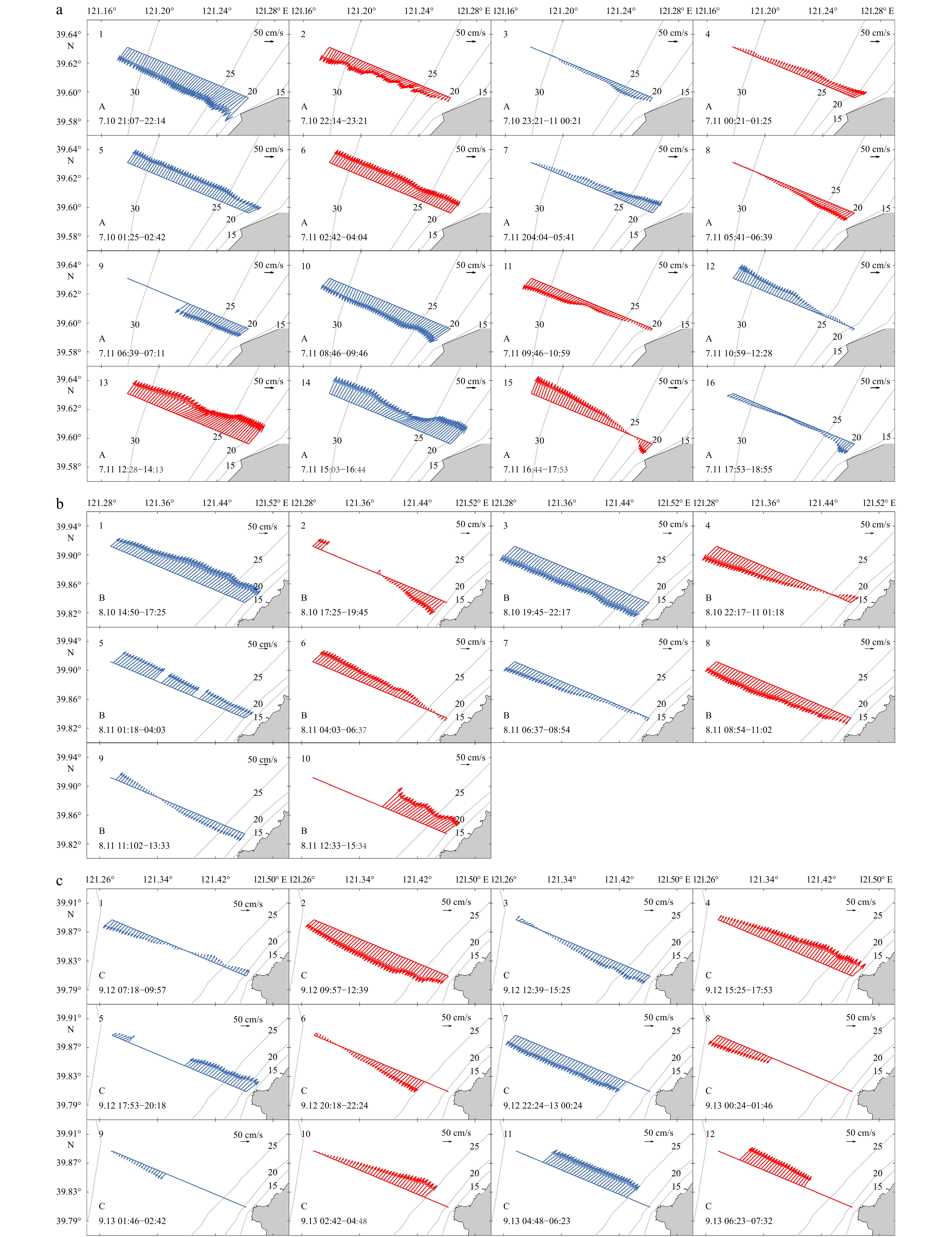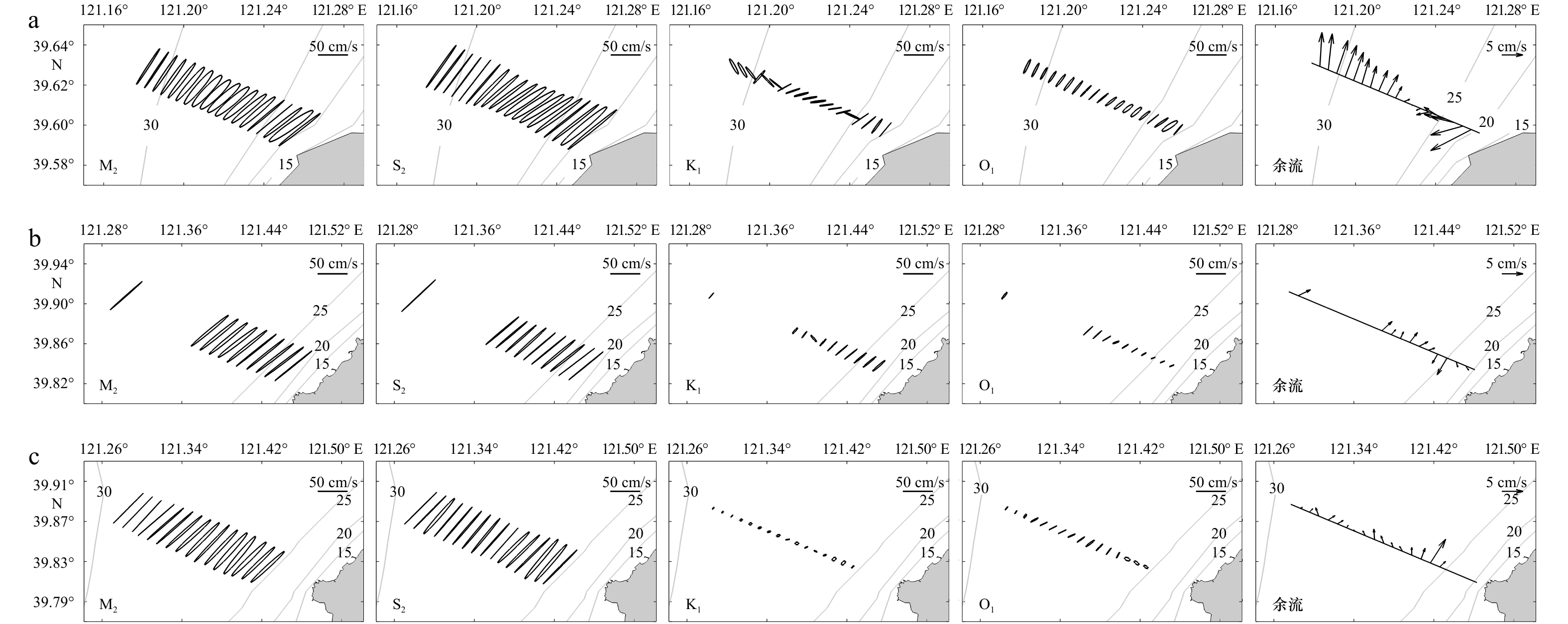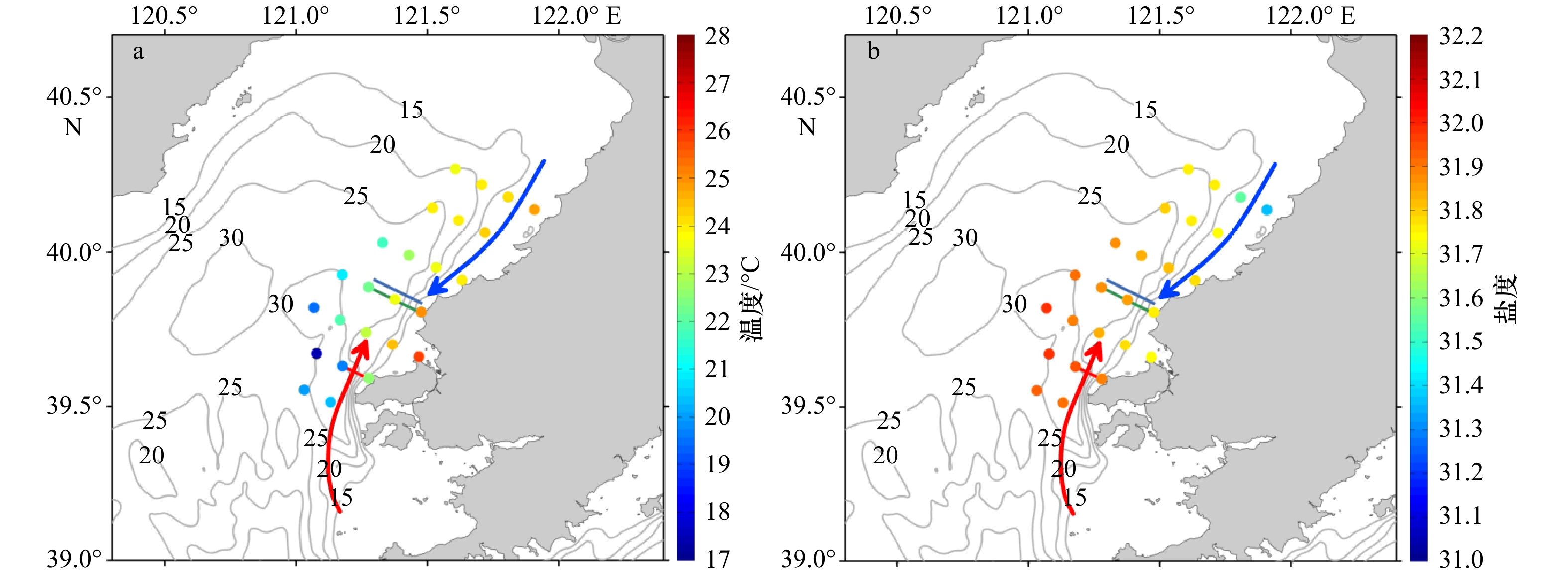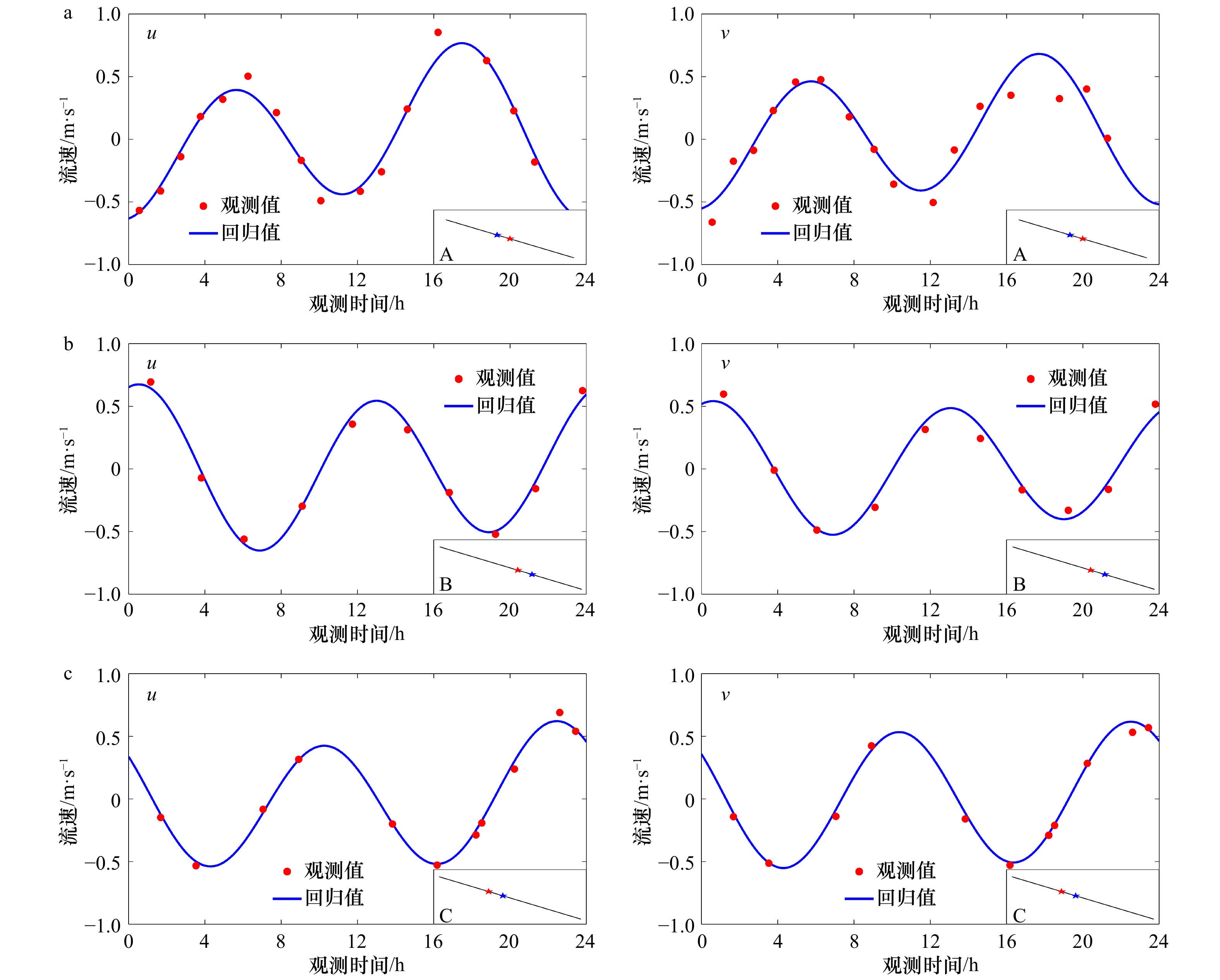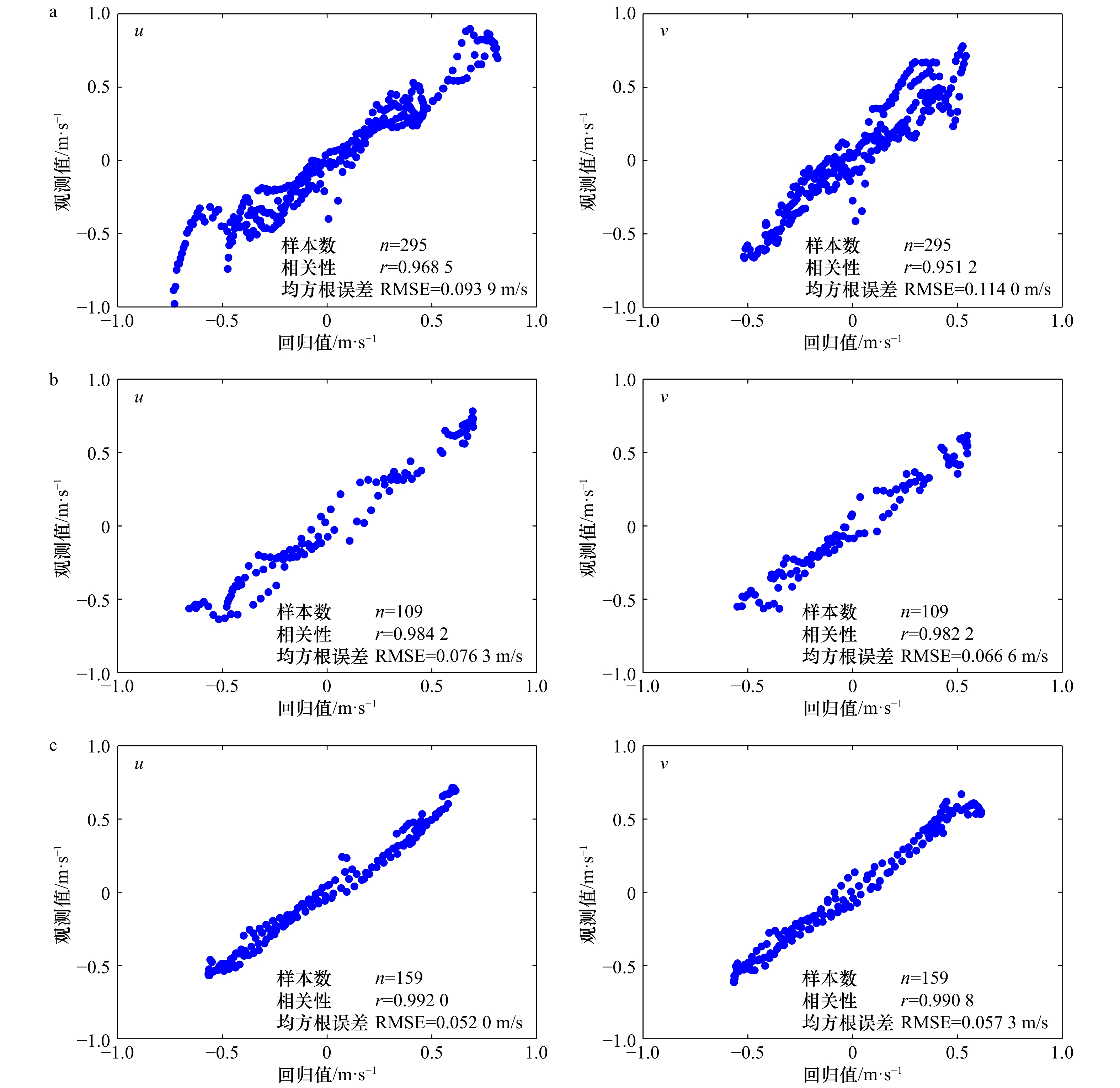Separation of tidal and residual current based on ship-mounted ADCP data around area of Hongyanhe Nuclear Power Station
-
摘要: 基于红沿河核电站取水口周边海域3个不同断面的船载ADCP短期重复走航观测资料,采用传统调和分析方法和L曲线方法对该资料进行潮流–余流分离计算,并通过对比潮流特征、分析水团运动和余流流向的关系,以及对分离后的潮流与余流进行回报,验证L曲线方法对观测时间较短、重复次数不多的走航ADCP资料进行潮流分离的合理性与有效性。结果表明:(1)应用L曲线方法分离的潮流特征与以往的观测结果较为一致,该方法可有效分离半日潮流与全日潮流,但本文采用的数据长度小于1个典型全日潮周期长度,故整个全日潮族以及区内流场动力方面的分析结果尚存不合理之处,还需采用观测时间较长、重复次数较多的走航观测资料改进;(2)分离后的余流近岸向南、离岸向北的分布,符合观测海域的温盐要素分布,余流结果具有合理性;(3) L曲线方法的回归值与实测瞬时流速线性拟合的相关程度较高,均方根误差为6 cm/s左右,相对误差百分比约为10%。该方法可拓展并推广到近海其他关键断面走航流速观测的潮流分离中,以获得流速特征与物质输运通量等重要信息。
-
关键词:
- 近海潮流-余流分离 /
- L曲线方法 /
- 重复走航ADCP观测
Abstract: Based on the repeated short-term shipboard Acoustic Doppler Current Profiler (ADCP) surveys of three sections around the coastal area of Hongyanhe Nuclear Power Station, the L-curve method was used to separate tidal and residual current. The relationship between the movement of water masses and the direction of residual currents was analyzed and the characteristics of tidal currents were compared with literatures. Regression analysis of flow field verified that L-curve method for de-tiding under this situation was reasonable. The results suggested that: (1) The tidal current characteristics separated by L-curve method were in good agreement with the previous observations, and the semi-diurnal and diurnal tidal current components can be separated effectively, but all of data used in this paper were less than typical diurnal period. Therefore, the results of diurnal current and dynamic analysis of the flow field were still unreasonable. We need to use observations with longer time and more repetitions to correct the deficiency. (2) The residual currents flew to southward nearshore and northward offshore, which was consistent with colder saltier water intruding from south in deep water and warm fresh water run from north along the coastline. (3) The regression values derived from the L-curve method were highly correlated with the measured instantaneous velocity. The root mean square error (RMSE) was about 6 cm/s, and the relative error was about 10%. L-curve method can be extended to de-tide at any critical sections to obtain the important information such as coastal circulation variation and material transport fluxes to estimate the water exchange and resident time.-
Key words:
- coastal de-tiding /
- L-curve method /
- repeated shipboard ADCP observation
-
图 2 深度平均瞬时流时间序列
a. A断面;b. B断面;c. C断面。左上角的数字表示走航观测序数,左下角表示此次观测的时间,航线上的矢量箭头代表深度平均流,矢量箭头的颜色表示观测船的行驶方向,蓝色表示船的行驶方向是向西的,红色表示船的行驶方向是向东的,航线上的空白部分表示数据缺失
Fig. 2 Time series of the depth-averaged instantaneous current
a. Section A; b. Section B; c. Section C. The number on the top-left corner of each plot is the cruise count. Arrows are depth-averaged currents measured by shipboard ADCP. The color of the arrows indicates the direction of the ship movement. The blue arrows indicate that the ship was moving westward, while the red arrows indicate that the ship was moving eastward. Blank parts of sections denote missing data
图 6 L曲线方法的回归流速时间序列与走航观测瞬时流速的比较
a. A断面;b. B断面;c. C断面。红点表示实验组走航观测瞬时流速,蓝线表示以对照组计算的调和常数回归实验组流速的时间序列。右下角的小图表示断面,蓝色五角星表示对照组选取空间点的位置,红色五角星表示实验组选取空间点的位置
Fig. 6 Comparison between the instantaneous velocity of the shipboard ADCP and the regression derived from L-curve method
a. Section A; b. Section B; c. Section C. The red points indicate instantaneous velocity of test group’s observation, while the blue lines represent the time series of regressed velocity calculated by Control Group’s harmonic constants. The subplot on the bottom-right corner of each plot shows the section. The blue pentagram indicates the location of the control group point while the red pentagram indicates the test group point
表 1 走航ADCP观测信息
Tab. 1 Information of shipboard ADCP observations
断面 开始时间 结束时间 断面长度/km 重复走航次数 A 7月10日21:07 7月11日18:55 8 16 B 8月10日14:50 8月11日15:34 18 10 C 9月12日07:18 9月13日07:32 18 12 表 2 走航ADCP主要参数
Tab. 2 Major parameters of shipboard ADCP
频率 仪器精度 盲区 呯间隔 300 kHz ±0.70% 0.5 m 1 s 层厚 层数 换能器入水深度 首层深度 1 m 40 1.5 m 2 m 表 3 潮流椭圆参数
Tab. 3 Parameters of tidal current ellipses
断面 分潮 椭圆长半轴长/cm·s−1 椭圆主轴方向/(°) 椭圆椭率 A M2 37.84±2.75 45.09±7.26 0.097±0.056 S2 44.27±3.67 41.77±8.16 0.054±0.034 K1 13.97±1.43 59.55±53.85 0.066±0.044 O1 12.48±1.20 46.05±9.97 0.124±0.006 B M2 40.56±1.93 42.69±1.22 0.042±0.019 S2 36.30±1.52 43.98±1.70 0.024±0.016 K1 10.30±3.39 52.03±26.49 0.087±0.051 O1 6.59±2.23 30.83±11.00 0.065±0.047 C M2 39.26±2.07 44.36±2.74 0.048±0.033 S2 38.16±2.19 47.51±2.41 0.034±0.023 K1 3.07±0.60 47.14±50.73 0.361±0.205 O1 6.23±1.78 61.46±45.99 0.159±0.157 注:各项参数数值表示断面上所有点的平均值±标准差。 -
[1] 冯士筰, 李凤岐, 李少菁. 海洋科学导论[M]. 北京: 高等教育出版社, 1999.Feng Shizuo, Li Fengqi, Li Shaojing. An Introduction to Marine Science[M]. Beijing: Higher Education Press, 1999. [2] 张芩. 船载ADCP资料的潮流分离技术[J]. 海洋通报, 2000, 19(4): 49−55. doi: 10.3969/j.issn.1001-6392.2000.04.008Zhang Qin. Techniques for tidal currents separation from ship-mounted ADCP data[J]. Marine Science Bulletin, 2000, 19(4): 49−55. doi: 10.3969/j.issn.1001-6392.2000.04.008 [3] Foreman M G G, Freeland H J. A comparison of techniques for tide removal from ship-mounted acoustic Doppler measurements along the southwest coast of Vancouver Island[J]. Journal of Geophysical Research: Oceans, 1991, 96(C9): 17007−17021. doi: 10.1029/91JC01314 [4] Isobe A, Kuramitsu T, Nozaki H, et al. Reliability of ADCP data detided with a numerical model on the East China Sea shelf[J]. Journal of Oceanography, 2007, 63(1): 135−141. doi: 10.1007/s10872-007-0011-z [5] Candela J, Beardsley R C, Limeburner R. Separation of tidal and subtidal currents in ship-mounted acoustic Doppler current profiler observations[J]. Journal of Geophysical Research: Oceans, 1992, 97(C1): 769−788. doi: 10.1029/91JC02569 [6] Münchow A. Detiding three-dimensional velocity survey data in coastal waters[J]. Journal of Atmospheric and Oceanic Technology, 2000, 17(5): 736−748. doi: 10.1175/1520-0426(2000)017<0736:DTDVSD>2.0.CO;2 [7] Wang Yuhuai, Jan S, Wang Dongping. Transports and tidal current estimates in the Taiwan Strait from shipboard ADCP observations (1999-2001)[J]. Estuarine, Coastal and Shelf Science, 2003, 57(1/2): 193−199. [8] 黄奖, 葛勇. 船载ADCP资料的潮流分离方法在厦门港断面重复走航中的应用[J]. 台湾海峡, 2009, 28(1): 123−129.Huang Jiang, Ge Yong. Application of the separation of tidal and subtidal currents for ship-mounted ADCP data from repeating measurements in a transect of Xiamen Harbor[J]. Journal of Oceanography in Taiwan Strait, 2009, 28(1): 123−129. [9] 崔欣梅, 华锋, 高大鲁. 台湾海峡夏季走航ADCP资料的滤潮处理[J]. 海洋科学进展, 2011, 29(4): 446−454. doi: 10.3969/j.issn.1671-6647.2011.04.004Cui Xinmei, Hua Feng, Gao Dalu. Tidal current separation from ship-mounted ADCP measurements in summer in Taiwan Strait[J]. Advances in Marine Science, 2011, 29(4): 446−454. doi: 10.3969/j.issn.1671-6647.2011.04.004 [10] 姚志刚, 鲍献文, 李娜, 等. 基于船载ADCP观测对罗源湾湾口断面潮流及余流的分析[J]. 海洋学报, 2012, 34(6): 1−10.Yao Zhigang, Bao Xianwen, Li Na, et al. Analysis of tidal and residual currents across Kemen Channel based on shipboard ADCP measurements[J]. Haiyang Xuebao, 2012, 34(6): 1−10. [11] 沈俊强, 潘伟然, 张国荣, 等. 基于三维调和分离的同安湾口门断面冬季潮流和余流特征的分析[J]. 台湾海峡, 2012, 31(3): 338−344.Shen Junqiang, Pan Weiran, Zhang Guorong, et al. Analysis of tidal and residual current characteristics at the cross-section of Tong'an Bay entrance in winter based on the 3-D harmonic separation method[J]. Journal of Oceanography in Taiwan Strait, 2012, 31(3): 338−344. [12] 沈俊强, 潘伟然, 张国荣, 等. 基于走航ADCP资料的厦门内湾东西口门海域潮流与潮致余流特征分析[J]. 应用海洋学学报, 2014, 33(3): 395−403. doi: 10.3969/J.ISSN.2095-4972.2014.03.015Shen Junqiang, Pan Weiran, Zhang Guorong, et al. Analysis of tidal and tidal induced residual current characterisitics based on ship-mounted ADCP data in east and west mouth inside Xiamen Bay[J]. Journal of Applied Oceanography, 2014, 33(3): 395−403. doi: 10.3969/J.ISSN.2095-4972.2014.03.015 [13] 万凯, 鲍献文, 姚志刚, 等. 沙埕港湾口断面潮流及余流特征分析[J]. 海洋与湖沼, 2014, 45(4): 669−675. doi: 10.11693/hyhz20130315002Wan Kai, Bao Xianwen, Yao Zhigang, et al. Tidal and residual current characteristics at mouth of Shangchenggang Channel[J]. Oceanologia et Limnologia Sinica, 2014, 45(4): 669−675. doi: 10.11693/hyhz20130315002 [14] 沈俊强, 孙豪为, 潘爱军, 等. 基于夏季船载ADCP数据的台湾海峡西南部平均流与潮流特征的初步研究[J]. 热带海洋学报, 2016, 35(3): 11−19. doi: 10.11978/2015100Shen Junqiang, Sun Haowei, Pan Aijun, et al. Study on characteristics of mean flow and tidal currents in the southwestern Taiwan Strait based on shipboard ADCP observations in summertime[J]. Journal of Tropical Oceanography, 2016, 35(3): 11−19. doi: 10.11978/2015100 [15] Katoh O, Teshima K, Abe O, et al. Process of the Tsushima current formation revealed by ADCP measurements in summer[J]. Journal of Oceanography, 1996, 52(4): 491−507. doi: 10.1007/BF02239051 [16] Liu K K, Tang T Y, Gong G C, et al. Cross-shelf and along-shelf nutrient fluxes derived from flow fields and chemical hydrography observed in the southern East China Sea off northern Taiwan[J]. Continental Shelf Research, 2000, 20(4/5): 493−523. [17] Katoh O, Morinaga K, Nakagawa N. Current distributions in the southern East China Sea in summer[J]. Journal of Geophysical Research: Oceans, 2000, 105(C4): 8565−8573. doi: 10.1029/1999JC900309 [18] Jan S, Chao S Y. Seasonal variation of volume transport in the major inflow region of the Taiwan Strait: the Penghu Channel[J]. Deep Sea Research Part II: Topical Studies in Oceanography, 2003, 50(6/7): 1117−1126. [19] Chang Y C, Tseng R S, Liu C T. Evaluation of tidal removal method using phase average technique from ADCP surveys along the Peng-Hu Channel in the Taiwan Strait[J]. Terrestrial Atmospheric and Oceanic Sciences, 2008, 19(4): 433−443. doi: 10.3319/TAO.2008.19.4.433(Oc) [20] Wu Hui, Deng Bing, Yuan Rui, et al. Detiding measurement on transport of the Changjiang-derived Buoyant coastal current[J]. Journal of Physical Oceanography, 2013, 43(11): 2388−2399. doi: 10.1175/JPO-D-12-0158.1 [21] Zhu Xiaohua, Ma Yunlong, Guo Xinyu, et al. Tidal and residual currents in the Qiongzhou Strait estimated from shipboard ADCP data using a modified tidal harmonic analysis method[J]. Journal of Geophysical Research: Oceans, 2014, 119(11): 8039−8060. doi: 10.1002/2014JC009855 [22] Hansen P C. Analysis of discrete ill-posed problems by means of the L-curve[J]. SIAM Review, 1992, 34(4): 561−580. doi: 10.1137/1034115 [23] Hansen P C, O'Leary D P. The use of the L-curve in the regularization of discrete ill-posed problems[J]. SIAM Journal on Scientific Computing, 1993, 14(6): 1487−1503. doi: 10.1137/0914086 [24] 海洋图集编委会. 渤海黄海东海海洋图集: 水文[M]. 北京: 海洋出版社, 1993.Editorial Board for Marine Atlas. Marine Atlas of Bohai Sea, Yellow Sea, East China Sea Hydrology[M]. Beijing: China Ocean Press, 1993. [25] 赵保仁, 庄国文, 曹德明, 等. 渤海的环流、潮余流及其对沉积物分布的影响[J]. 海洋与湖沼, 1995, 26(5): 466−473. doi: 10.3321/j.issn:0029-814X.1995.05.003Zhao Baoren, Zhuang Guowen, Cao Deming, et al. Circulation, tidal residual currents and their effects on the sedimentations in the Bohai Sea[J]. Oceanologia et Limnologia Sinica, 1995, 26(5): 466−473. doi: 10.3321/j.issn:0029-814X.1995.05.003 [26] 王凯, 方国洪, 冯士筰. 渤海、黄海、东海M2潮汐潮流的三维数值模拟[J]. 海洋学报, 1999, 21(4): 1−13.Wang Kai, Fang Guohong, Feng Shizuo. A 3-D numerical simulation of M2 tides and tidal currents in the Bohai Sea, the Huanghai Sea and the East China Sea[J]. Haiyang Xuebao, 1999, 21(4): 1−13. [27] Liu Zhe, Wang Haiyan, Guo Xinyu, et al. The age of Yellow River water in the Bohai Sea[J]. Journal of Geophysical Research: Oceans, 2012, 117(C11): C11006. [28] Zhou Feng, Huang Daji, Xue Huijie, et al. Circulations associated with cold pools in the Bohai Sea on the Chinese continental shelf[J]. Continental Shelf Research, 2017, 137: 25−38. doi: 10.1016/j.csr.2017.02.005 -




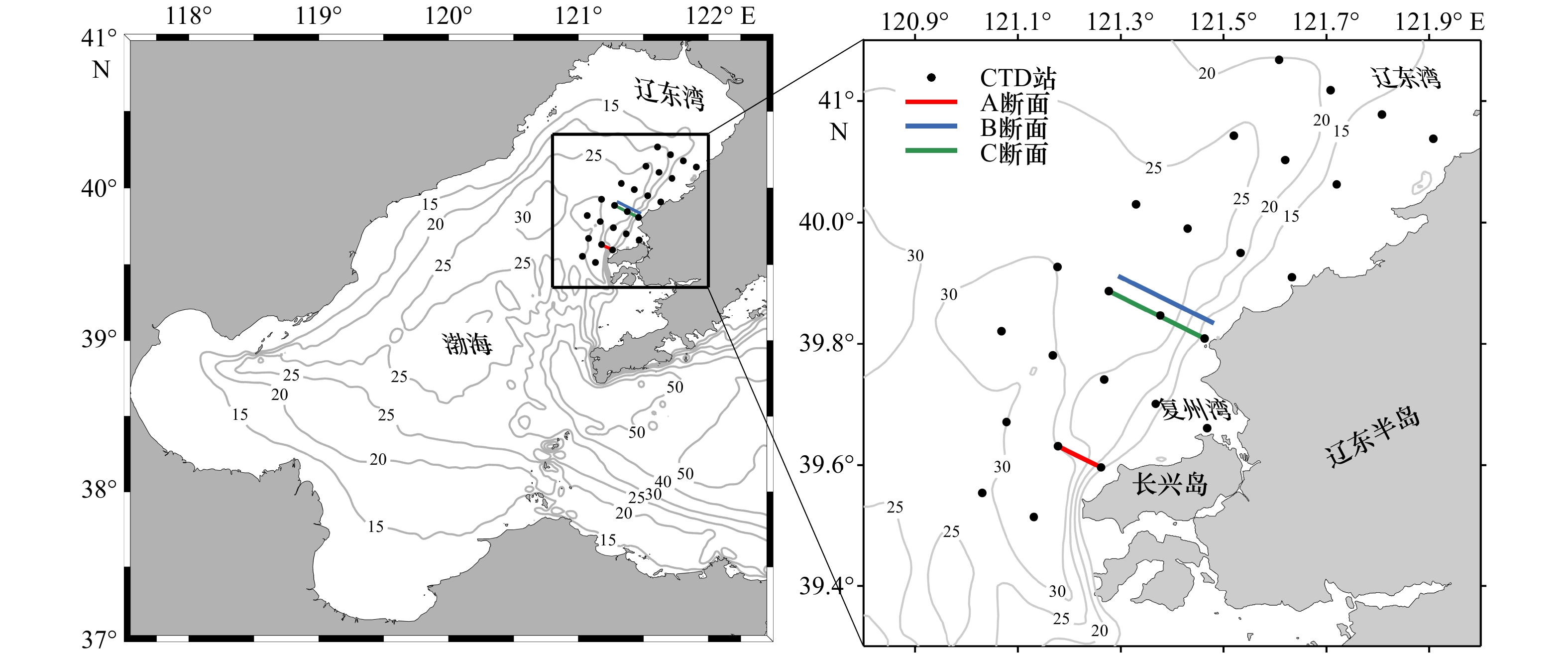
 下载:
下载:
